|
GOVARDHAN GARDENS
VIRTUAL TOUR
|
Welcome to Govardhan Garden’s Virtual
Tour!
This tour is not what many may expect - a
Disneyland-inspired
series of pretty landscape pictures as seen on countless
nature-related web sites. Instead, it is attempting to show another
perspective of ecological farming in the tropics: a connection with nature on
a deep spiritual, intellectual and artistic level.
As so
eloquently expressed in a famous song by Robert Nesta Marley, “There’s a natural mystic blowing through the air, if you
listen carefully now you will hear” - this is exactly what this Virtual
Tour is attempting to capture.
In
collaboration with globetrotting photographer Juanse ( www.bitacurry.com), our main goal is to inspire a
deeper sense of admiration for and understanding of nature, and the
various eco farmers
in the tropics who are trying to create role models of
sustainable havens. Our intention is to let this project grow indefinitely
over time and inspire like-minded stewards of nature.
The commentaries are signed with the initials of the
writers, which are currently: S/G (Sadhu Govardhan) and JSe (Dr. Juanse
Ramirez). We are both committed to regularly update this
page, so check back at least once a month.
There is a related article, "Birds at Govardhan Gardens"
that includes pictures of most of
the bird species living at or frequenting the farm on a regular basis.
If
you would like to participate in this project or would like more information,
please contact me: sadhu@coqui.net
|
"A Few Square
Feet of Natural Perfection"
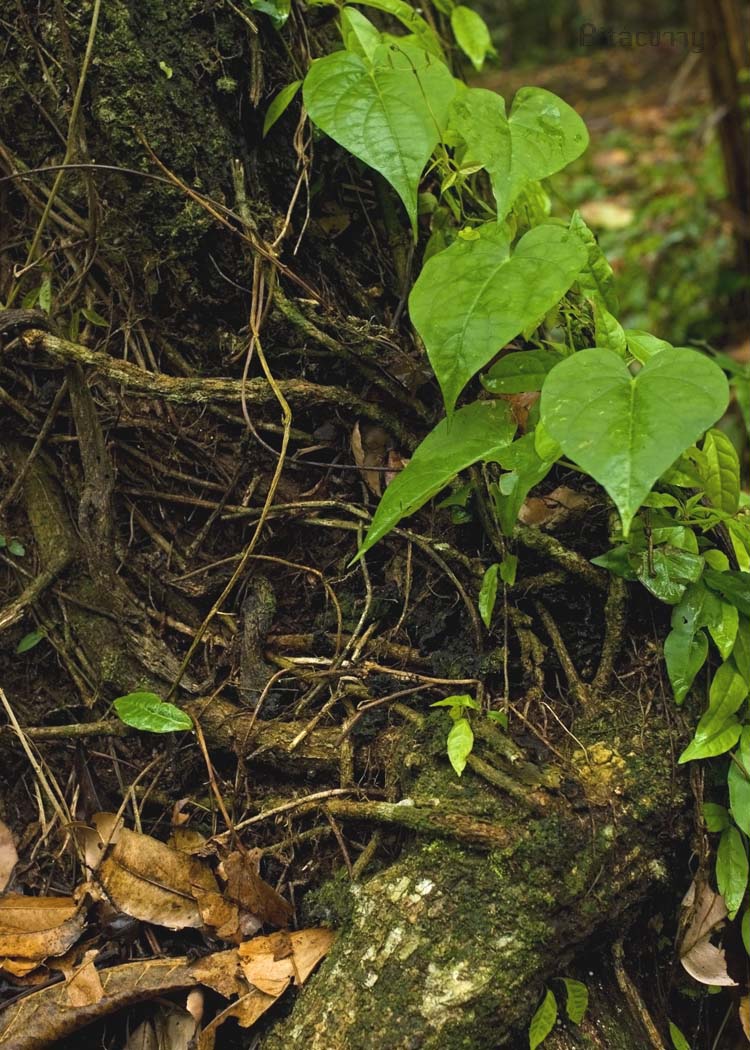
This is the abundant
life I want to observe - protected by fragile physical
boundaries in the heart of Govardhan Gardens.
This is the world I
prefer to live in, far from the self-destructive nightmare we
have created in the name of progress and civilization. It is a luxury of
life to
be a steward of even the tiniest piece of protected nature.
Birthing,
flourishing, aging and transforming of energy without waste or
contamination are still taking their natural course here.
Despite
the wars fought underneath and above the surface,
I feel a calming serenity.
All elements live
together as an autonomous and dynamic unit,
interconnected with all of Mother Earth. S/G
|
|
|
"I am a Photon"
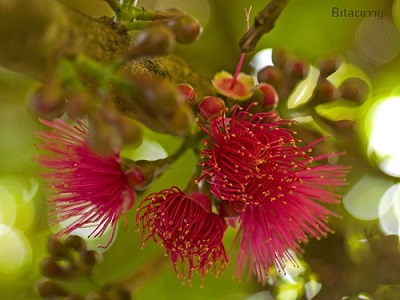
Three
million Kelvin fuse me to life and with a big burst of energy
I'm instantly pushed into the big empty. Constant
collisions and chance are my guides. Eight minutes and
nineteen seconds later I reach my destination to ignite
another set of reactions with much sweeter consequences.
My arrival unleashes a wave of excitement; everything is
bouncing, water is so energized that it falls apart. A
wave of hydrogen awakens the energy required to sweeten this
deal. The oxygen is released, allowing the guy on the
keyboard pretending to be me to breathe.
My initial
intentions to incite and to excite are displaced by a deeper sense of
purpose. The shapes and forms that have arisen by the likes of me
are beautiful. Now I work for something larger, something that in
the end will only be the beginning, as I will surely go up in flames and
go back to what I was, light. JSe
2
weeks later....

...the
trunks of the trees are surrounded by a stunning bed of flower petals.
|
|
|
"How long am I allowed to
exist?"
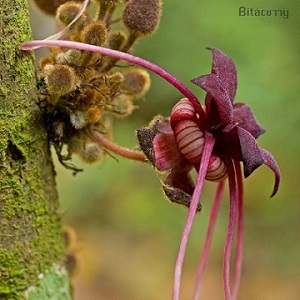
|
|
|
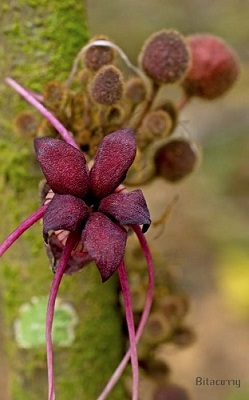 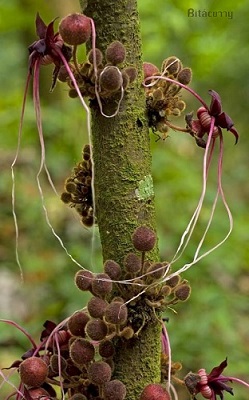
These amazing looking
flowers are from a species called Herrania
purpurea, a very close relative of the more commonly grown Theobroma cacao
(cocoa, chocolate tree). There are several dozen cacao types (with hundreds
of cultivars) and just like this species, most of them have very sweet,
tasty pulp around the seeds. Both, the pulp and the seeds are
used to make drinks. This particular cacao is loved by people as well
as various jungle dwellers - mostly monkeys (hence the name "monkey
cacao) - and has the appearance of a dwarf cacao.
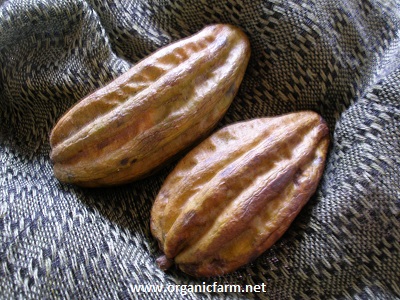
Since this type of cacao is
wild and it's commercial potential is only realized and appreciated
locally, it will have to struggle for survival. Of the thousands of
tropical fruit species existing, almost half are in danger of extinction.
The main causes for that sad fact are: the systematic destruction of
rainforests (primarily the Amazon and Borneo), and a centralized food
industry that pushes all "lesser profitable" species aside. As
bizarre as it may sound, we are approaching a time when governments will
determine what people are allowed to grow and what not. Every year, an
increasing number of plants is being black listed or extinct. S/G
|
|
|
"Bixa orellana"

Names always tell a
story. Botanical names usually
tell stories
of morphology and physiology but occasionally they share tales
of randomness with historical consequences.
Francisco de Orellana, a 16th Century Spanish explorer and conquistador,
was inked into the history books as “The
man who led the first known navigation
of the Amazon River.” Interestingly, his journey to the Amazon
was
purely accidental.About two centuries later, when the day came to
name a small shrub with the prized seeds that have painted red everything
from a cocoa drink for a Mayan ritual to your fingers after eating
Cheetos, Francisco de Orellana’s name came to mind - regardless
the fact that he had nothing to do with this plant.
Bixa orellana or achiote is the
colonized version of achiotl, the
word
for shrub in the Nahuatl language of The People of The Sun. This prolific
bearer is native to continental tropical America and Asia has been
cultivated for thousands
of years. The seeds of urucum, as it is known in Brazil,
have been soaked, boiled
or crushed and used as dyes, natural food colorings or bodily decoration
in many traditional cultures, earning it the moniker Lipstick Tree.
JSe
|
|
|
Endosymbiosis
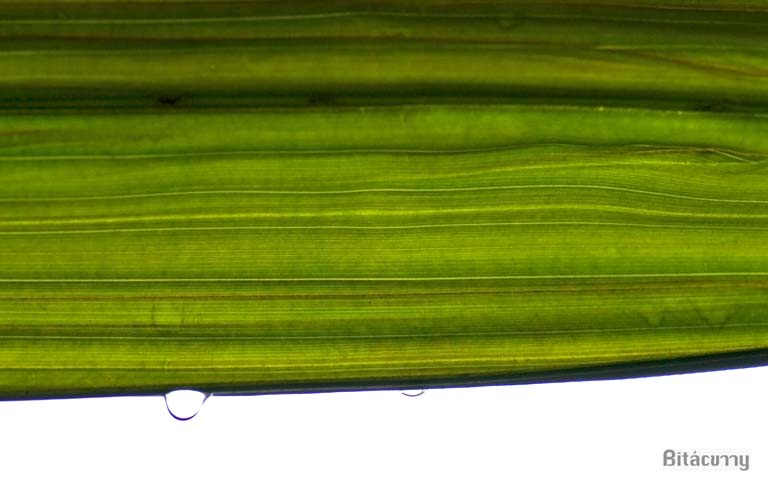
|
The endosymbiotic theory
postulates that at some point in the development of life forms as we know
them a small free-living bacteria settled within a larger cell. A mutually
beneficial relationship was established where the larger cell would provide
shelter to the vulnerable single-celled organism while the endosymbiont
would confer additional functional features to the larger cell.
This theory is used to
explain how larger more complex eukaryotic cells got their parts or
organelles. Among the organelles proposed to be of endosymbiotic descent
are the mitochondria, which pays the rent by producing large amounts of
chemical energy and chloroplasts that house the molecular machinery
required to convert the light energy of the sun into chemical energy.
Interestingly enough, both of these organelles have their own DNA, hinting
that they were once free before becoming servants. JSe
|
|
|
Banana
Birth
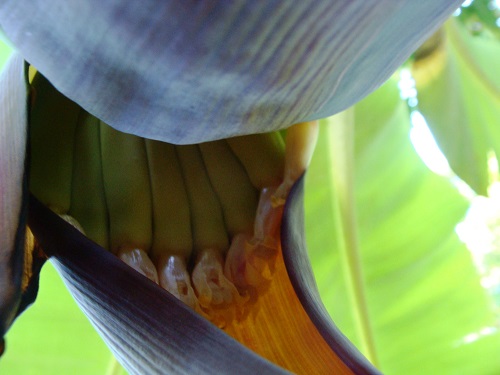
The banana
"tree" (Musa
x paradisiaca) is a large herb that forms
"berries" (fruits) parthenocarpically (without pollination).
The ovaries contained in the female flowers develop into clusters of
fruits, also called "hands". The birth of a banana hand easily
matches the most miraculous births in nature.
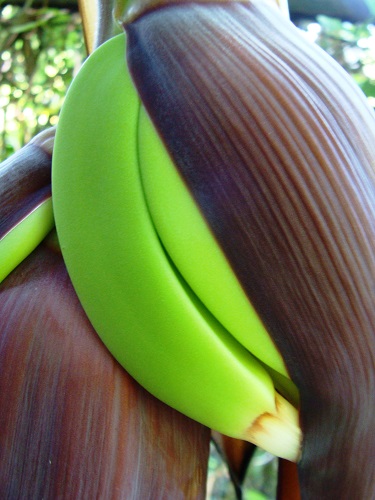
The process of the
plant giving birth to a handful of bananas is an adventurous and
mysterious morphological journey. Who would imagine the end result
when seeing just the rhizome of the plant? Similarly, most
people are not able to see the end result of a society that is built
upon the ruthless exploitation of natures resources as if there
were no tomorrow. A sustainable lifestyle gives birth to limitless
beauty, while a materialistic lifestyle gives birth to false glitters
that eventually turn into toxic ashes. S/G
|
Structure
and Precision

Nature shows us so
many faces – one of them is that of structure and precision, found in ferns
(Pteridophytes): strength that
supports delicacy – a striking display of unity in purpose. Modern society
tends to judge plants by how useful or profitable they are to humans,
largely ignoring the countless valuable lessons one can derive from each
and every plant. When naturally appearing evolved structure and precision
are combined with delicacy and purposeful unity, I see grace, gentle
strength and beauty. S/G
|
|
Natural decay = Improved Eco Health
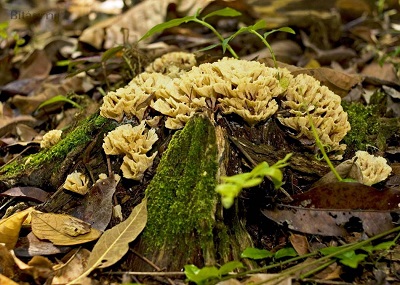


This
parasitic fungus (saprotroph) is feasting on a dead tree stump
and is in the process of speeding up the process of wood rot. The result
is highly nutritious organic matter that becomes available to a wide range of
invertebrate species,
who in turn create
more beneficial organic matter; this transformed organic matter
is improving the life of countless beneficial soil
organisms. Thus, natural decay improves ecological health.
While nature improves itself constantly, mankind does exactly the opposite:
we pollute and destroy whatever we can, and we create dangerous
waste - lots of it: the U.S. alone produces 11 billion tons of primarily
toxic waste annually. Millions of tons of toxic waste are dumped into oceans,
carcinogenic landfills or, if the waste is particularly hazardous,
preferably in foreign regions like Africa. Each of us has the choice to add
to the toxic garbage piles of the world or to work on positive solutions,
inspired by Mother Nature. S/G
Spira Mirabilis
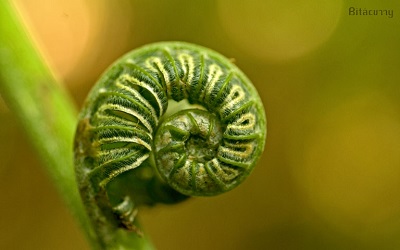
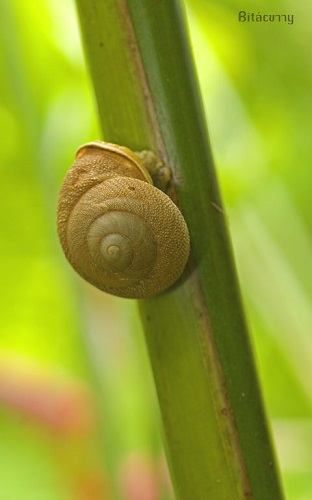
Shapes and patterns with surprising
similarity are observed repeatedly in Nature. Many thinkers, from
ancient Indian scholars to present day physicists, have attempted to
understand and decipher the secrets of these recurring motifs. The Spira
mirabilis is a fascinating example. As the size of the spiral
increases the shape is unaltered with each successive curve, meaning that
every increment in size is an amplification of the present structure.
Growth by copying existing forms leads to symmetrical patterns where the
whole is the same as its parts and parts are the same as the whole, which is
mathematically known as self-similarity. With complete disregard for
name and arithmetical details Nature uses it masterfully to generate its
unparalleled functional beauty that we have much to learn from. JSe
The Bridge
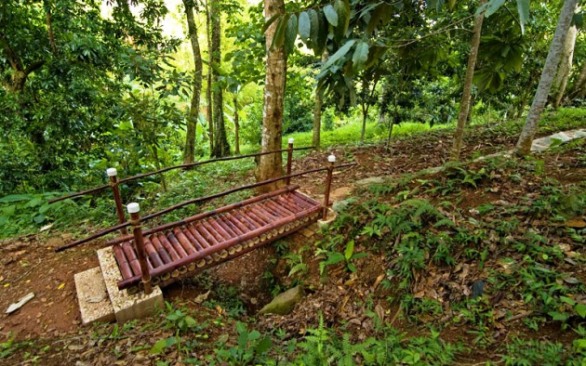
Already when I planted the first bamboo
species at Govardhan Gardens - Dendrocalamus
asper -
I knew that I would one day build a bridge. Years later, the first simple
pilot bridge made its appearance,
and to me it signifies the unlocking of the path to sustainability. The
bridge crosses over to a lifestyle long lost:
that of independence from outside resources and centralized powers. Growing
bamboo truly is one of
the main keys to self sufficiency and sustainability, especially for a
small-scale eco farmer:
it means growing one's own housing, furniture, food, medicine, tools,
windbreaks, erosion
control and an aesthetic functionality that can improve any tropical farm.
Ultimately, it is like crossing over to another life.
S/G
The Last One
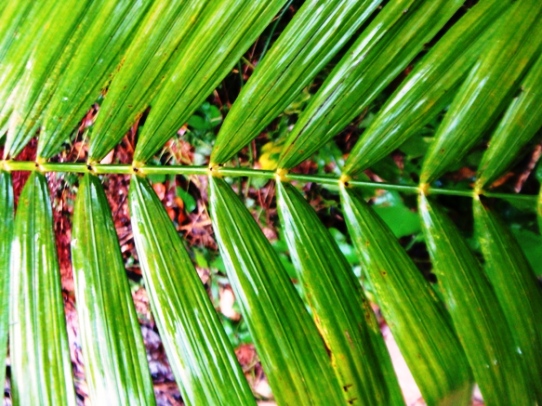
Today,
I planted three palm species – Phytelepha
macrocarpa (Ivory Palm), Butia
capitata (Jelly Palm) and Pseudophoenix
vinivera (Wine Palm). I never searched for palm species like a collector;
instead, my main criteria were the usefulness of the species: can the leaves
be used for a thatched roof? Does the species attract parrots or other birds
in danger of extinction? Does the palm have high quality fruits? Or do the
seeds contain a valuable oil? I never went much out of my way to acquire a
particular species, but today, when I planted the two Ivory palms (the seeds
are used for intricate miniature carvings), I realized that this is the last
palm species I actually endeavoured to “hunt” down.
At
one point in life, everything becomes the “last one” or the “last time”. This
is part of living in the material world, and it is wise to realize when
to stop, just like it is important to know when to start something or how to
develop or maintain it. New palm species will still be planted here, but
I won’t endeavour anymore to find one specific species.
This was it – the Ivory palm turned out to be The Last One. S/G
Success

There are many ways to define success in ecological
agriculture. As soon or as long as the definition involves the term
"sustainable", the definition is automatically legitimate.
Interestingly, only positive or transcendent energies are
sustainable; negative energies, in contrast, are always followed by pain and destruction.
The part of the farm shown here is an image of
success: old trees, grown in patterns that control water run off have
closed in on each other; only a modest amount of light reaches the surface
of the ground, which keeps the soil temperature at an optimal level for
beneficial soil organisms to thrive. Additionally, countless fallen leaves
are piling up and true topsoil can begin to develop again. Considering
that topsoil is almost non-existent in today's cultivated tropical
farms, the small area shown in this picture is a remarkable and outstanding success. S/G |
|
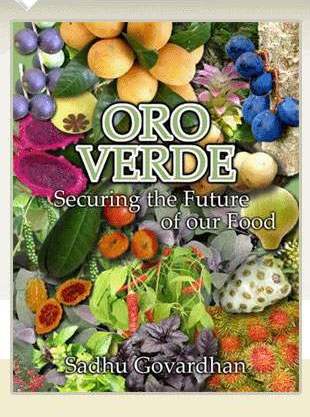
|
|
Gold or money has become the
standard benchmark of success in our society. Ironically, the pursuit of
this type of temporary wealth has primarily led to the exploitation of
humans, animals, plants and natural resources in general.
view ordering info 
|
|
|

|
|
 Sadhu Govardhan is an independent thinker, eco-organic
farmer, tropical rare fruit connoisseur and researcher. Extensive
journeys for over twenty years have allowed him to study indigenous
cultures and different life styles throughout the world. Sadhu Govardhan is an independent thinker, eco-organic
farmer, tropical rare fruit connoisseur and researcher. Extensive
journeys for over twenty years have allowed him to study indigenous
cultures and different life styles throughout the world.
His first
publications on philosophical and spiritual topics were published in
Europe and translated into several languages. He now lives in Puerto Rico
and has dedicated himself to researching and growing tropical food crops
and promoting alternative farming methods. He is currently involved with
consultant work and inspiring and developing educational organic role
model projects in the Caribbean.
read about the
project 
|
|
|

|
|
 I would like to extend a heartfelt thanks to everyone who
has helped out this project over the years. Even if I can't acknowledge
all of you individually since so many people have supported Govardhan
Gardens in so many ways, I certainly remember every one of you. I would like to extend a heartfelt thanks to everyone who
has helped out this project over the years. Even if I can't acknowledge
all of you individually since so many people have supported Govardhan
Gardens in so many ways, I certainly remember every one of you.
If you would like to find out more about the tree sponsoring program and
other opportunities to help the project, click here
view sponsors and friends

|
|
|
ECO
LIBRARY
|
|
This
revamped page is Govardhan Garden's new "eco
library". You can find videos, links, articles and other media
about relevant environmental topics.
Please contact me if you know of any additional good links
that you think should be a part of this library. Thank you.
|
view eco library 
|
|
|

Tropical Fruits Nursery Photos by Sadhu
Govardhan is licensed under a Creative Commons Attribution-Noncommercial-No Derivative
Works 3.0 United States License.
Permissions
beyond the scope of this license may be available at http://organicfarm.net/contact.htm.

|
|

































